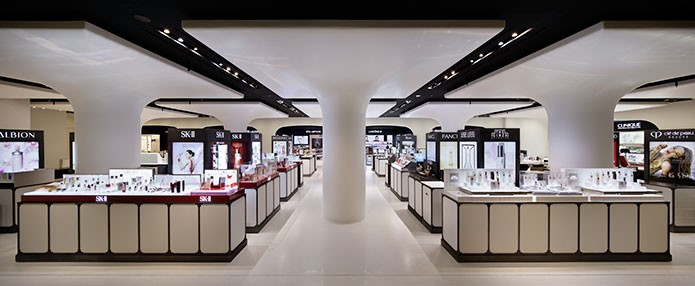
Nikkei Business (22 February) features a special report on how the Ginza area has become a centre for duty-free shopping by foreign visitors.
Three basic types of duty-free shop exist: those found in airports that cater to outbound travellers exempt from consumption tax and duty on cigarettes, alcohol and so on (resulting in savings of about 20%); those that operate in the same way, but are outside airports; and those in urban centres, where customers are exempt solely from consumption tax. Previously, only Okinawa Prefecture was permitted to operate shops in hotels or commercial areas according to the airport-shop model.
With a change in the law, airport-type duty-free shops are coming to Tokyo’s Chuo Ward.
On 27 January, Mitsukoshi Department Store in Ginza received permission to set up a bonded storage area, enabling it to start Japan Duty-Free Ginza, covering 3,300m2 on its 8th floor.
“If the share of purchases by foreigners exceeds 10%, we have to start preparing for them”, said Hiroshi Onishi, president of Isetan Mitsukoshi Holdings. Currently, foreigners’ purchases account for a share of over 25% at the Ginza branch.
Following on the heels of Mitsukoshi, on 31 March, a duty-free shop on the 8th and 9th floors of Tokyu Plaza Ginza, will open for business. With floor space of 4,400m2, it will be operated by South Korea’s Lotte Co., Ltd., which ranks third worldwide in duty-free sales.
A third complex will open in 2017 as part of the Ginza 6-chome redevelopment project, on the former site of the Matsuzakaya Ginza Department Store.
A 2014 survey—with multiple replies tallied—of foreign visitors conducted by the Tokyo Metropolitan Government shows that foreign visitors ranked Ginza as the second-most popular Tokyo destination, at 50%. First place was Shinjuku/Okubo (55.4%). Other top runners were Asakusa (49.2%), Shibuya (41.8%) and Akihabara (41.0%).
Duty-free shops are also likely to develop at regional airports where low-cost carriers operate. According to US firm RnR Market Research, the worldwide sales turnover of duty-free retailers is expected to grow 8.6% YoY from 2016 to surpass ¥8trn by 2019.
It is expected that China will be central to this figure. Moreover, as competition to sell to visitors from China intensifies, Miki Tsusaka, senior partner and managing director of the Boston Consulting Group, said Japan might be well advised to adopt a system, whereby the national government oversees duty-free sales, perhaps similar to that of South Korea. The position of the Japan National Tourism Organization, however, is that such commerce should be left in the hands of the private sector.
China, which wants its travellers to spend more money at home, in 2014 began an interesting experiment on its southern resort island of Hainan. It opened a 70,000m2 shopping centre, where 60% of the space is reserved for duty-free sales. There, both foreign-bound and Chinese domestic travellers pay identical prices for purchases. However, no pricing competition is evident, and the product selection is considerably smaller than at overseas duty-free shops. Thus, the impact of the world’s largest duty-free shopping centre on domestic sales is being watched with interest.
While China remains the most promising long-term growth market for Japan, fluctuations in the value of the Chinese yuan, and uncertainties regarding the strength of the Chinese economy remain blind spots with potential risks. Nikkei Business thus concludes that the new airport-type shops outside airports, especially those in the Ginza area, are likely to serve as acid tests for duty-free business endeavours.